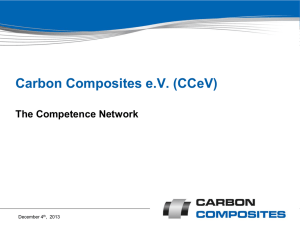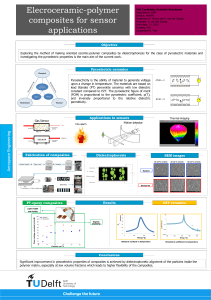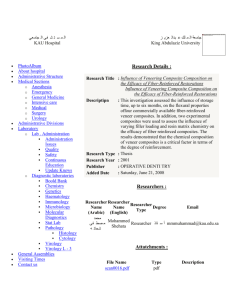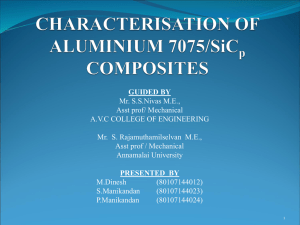thermal precursor
advertisement
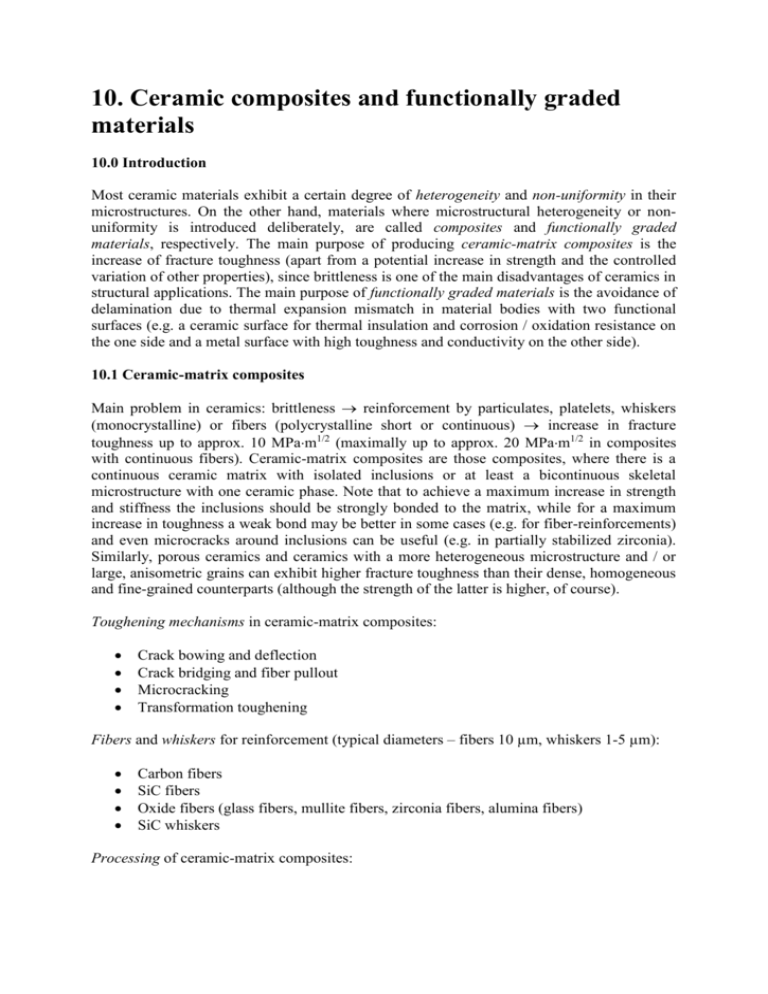
10. Ceramic composites and functionally graded materials 10.0 Introduction Most ceramic materials exhibit a certain degree of heterogeneity and non-uniformity in their microstructures. On the other hand, materials where microstructural heterogeneity or nonuniformity is introduced deliberately, are called composites and functionally graded materials, respectively. The main purpose of producing ceramic-matrix composites is the increase of fracture toughness (apart from a potential increase in strength and the controlled variation of other properties), since brittleness is one of the main disadvantages of ceramics in structural applications. The main purpose of functionally graded materials is the avoidance of delamination due to thermal expansion mismatch in material bodies with two functional surfaces (e.g. a ceramic surface for thermal insulation and corrosion / oxidation resistance on the one side and a metal surface with high toughness and conductivity on the other side). 10.1 Ceramic-matrix composites Main problem in ceramics: brittleness reinforcement by particulates, platelets, whiskers (monocrystalline) or fibers (polycrystalline short or continuous) increase in fracture toughness up to approx. 10 MPam1/2 (maximally up to approx. 20 MPam1/2 in composites with continuous fibers). Ceramic-matrix composites are those composites, where there is a continuous ceramic matrix with isolated inclusions or at least a bicontinuous skeletal microstructure with one ceramic phase. Note that to achieve a maximum increase in strength and stiffness the inclusions should be strongly bonded to the matrix, while for a maximum increase in toughness a weak bond may be better in some cases (e.g. for fiber-reinforcements) and even microcracks around inclusions can be useful (e.g. in partially stabilized zirconia). Similarly, porous ceramics and ceramics with a more heterogeneous microstructure and / or large, anisometric grains can exhibit higher fracture toughness than their dense, homogeneous and fine-grained counterparts (although the strength of the latter is higher, of course). Toughening mechanisms in ceramic-matrix composites: Crack bowing and deflection Crack bridging and fiber pullout Microcracking Transformation toughening Fibers and whiskers for reinforcement (typical diameters – fibers 10 µm, whiskers 1-5 µm): Carbon fibers SiC fibers Oxide fibers (glass fibers, mullite fibers, zirconia fibers, alumina fibers) SiC whiskers Processing of ceramic-matrix composites: Particulate-, platelet-, whisker- and short-fiber-reinforced ceramic-matrix composites can be fabricated via the usual ceramic processes used for multiphase ceramics. Whisker and shortfiber reinforced composites can be processed by hot pressing. For continuous-fiber reinforced composites the first step is building up a 3D architecture from the fibers by textile production techniques (weaving, stitching, knitting and braiding). For fiber- and whisker-reinforced composites, the reaction between the reinforcement and the matrix must be minimized, i.e. the processing temperature should not be too high. Chemical vapor impregnation (CVI) or liquid impregnation (ceramic precursor infiltration) with thermal decomposition (pyrolysis). Types of ceramic-matrix composites: Al2O3-ZrO2 composites SiC particulate / Si3N4 matrix composites SiC whisker / Al2O3 matrix composites SiC whisker / Si3N4 matrix composites Continuous fiber / glass matrix composites Carbon / carbon composites SiC / SiC composites Oxide / oxide composites. 10.2 Functionally graded materials FGM (= functionally graded materials or functional gradient materials) are materials with non-uniform microstructure, i.e. with (continuous or stepwise) changes of (chemical and / or phase) composition and / or microstructure. In contrast to conventional coatings or joined materials these changes in FGM are more gradual in order to improve adhesion and avoid separation at the boundary (delamination) caused by the thermal stresses developing due to thermal expansion mismatch, the main disadvantage of coated or joined materials. For adhesion, the thermal expansion mismatch should not exceed 25 %. In FGM the sharp boundary is replaced by a smooth transition region. Systems-analysis strategy “inverse design procedure”: geometry and boundary conditions; select materials; effective material properties are calculated for each composition (VoigtReuss or Hashin-Shtrikman bounds, effective medium theory); assuming a compositional gradient (distribution function) the thermal stresses are calculated for the required temperature difference; if not sufficiently below for the material strength the calculation is repeated with another compositional gradient or with other materials. A convenient distribution function for compositional gradients is A x x n , where A is the volume fraction of phase A, x the relative position in the FGM layer (i.e. a non-dimensional distance, normalized by the total thickness of the FGM layer) and n a freely adjustable parameter. Preparation of FGM using vapor phase, liquid phase and solid phase methods. Materials and applications (current or potential): Structural materials: The FGM concept was initially developed to reduce thermal stresses in thermal barrier materials ( thermal and mechanical aspects of FGM). Functional materials: Recent research – extending the FGM concept to electronic, magnetic, optical and biomedical materials.
